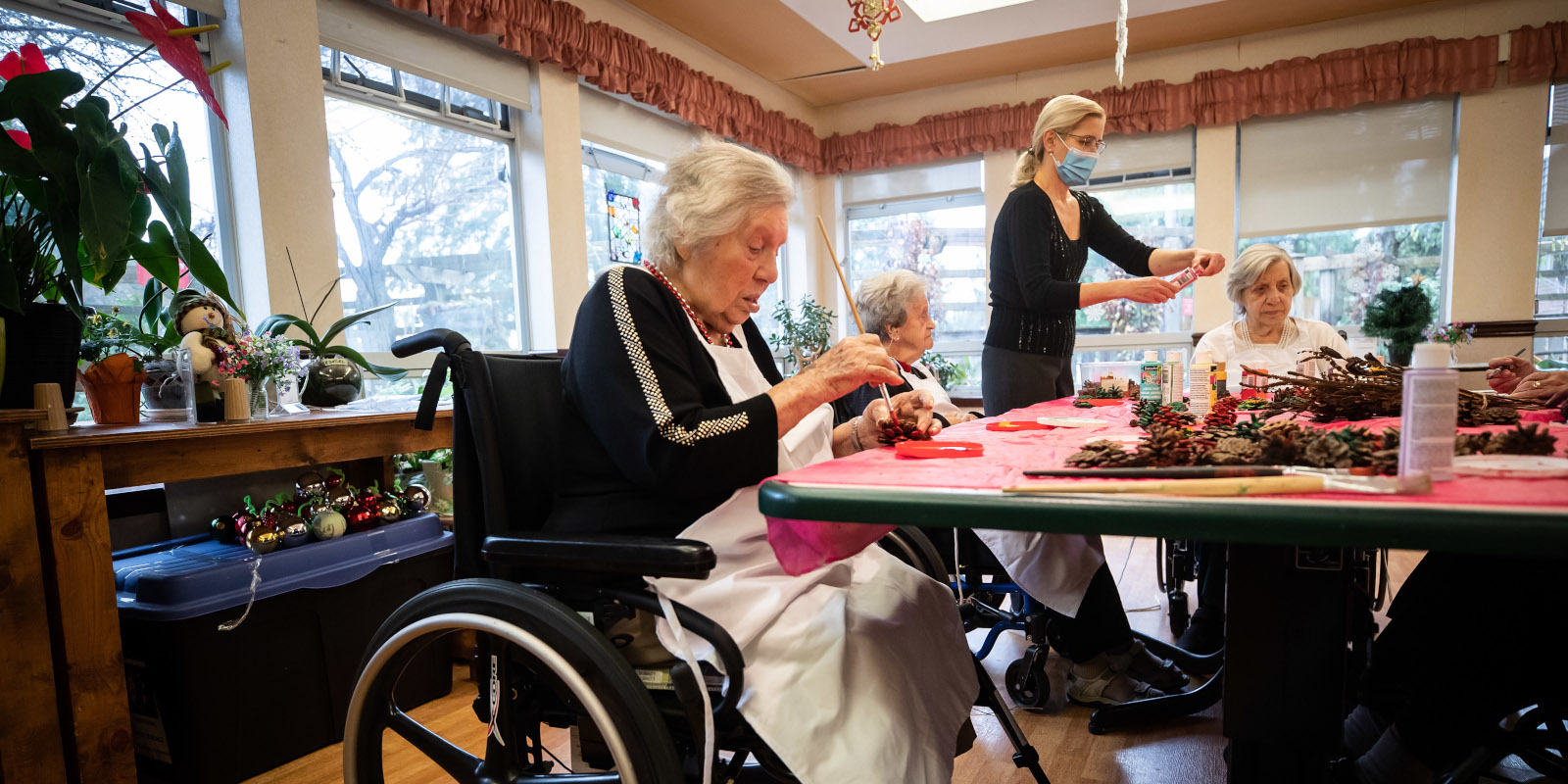Canada’s hospitals are increasingly overburdened, with too many patients and too few rooms and staff to keep up with demand. Similar challenges are being faced in the long-term care (LTC) system. Could a different approach to LTC help to tackle both problems?
In the winning submission for this year’s Hunter Prize for Public Policy, “Bringing Long-Term Care Home,” Dr. Ashley Flanagan, health research and policy manager at the National Institute on Ageing, and Dr. Kristina Kokorelias, program manager for Sinai Health and the University Health Network’s Healthy Ageing and Geriatrics Program, argue that it might.
Inspired by successful models in countries such as Denmark—and cognizant of Canada’s aging population—Flanagan and Kokorelias call for Canada to expand its home care options. Not only would this relieve the overreliance on traditional LTC homes, but it would also take some of the pressure off of hospitals—many of which are crowded with patients who require LTC but lack access. This has led to long wait times for emergency and elective procedures and the rise of “hallway medicine,” where care is provided in corridors and other nontraditional spaces due to a lack of available beds.
Flanagan and Kokorelias advocate for a “Virtual LTC at Home Program” through which integrated care teams would provide robust, cost-effective home care services to elderly persons living in their own households or with family. They suggest that this strategy could reduce the reliance on institutional care, potentially alleviate the strain on hospitals and LTC homes, and align with the preferences of most older Canadians. A 2022 Ipsos poll found that 95 percent of those asked wanted to age at home.
Implementation could bring savings
Alternatives to the current LTC system are urgently needed, especially as Canada’s health-care infrastructure deals with both the fallouts of the COVID-19 pandemic and an aging population. Some projections suggest that nearly one in three Canadians could be 65 or older by 2068.
Currently, 15 percent of acute-care hospital beds in Canada are occupied by patients who do not require acute care but have no other place to go to.
“Our long-term-care system was not really functioning at all right before COVID, but with COVID it basically collapsed entirely,” says Shawn Whatley, a physician and Munk senior fellow in health policy at the Macdonald-Laurier Institute.
Flanagan and Kokorelias suggest that their proposal could be implemented by utilizing existing infrastructure and community-based care providers to offer LTC-equivalent care at home. Coordinated care teams would involve key partners such as community support services agencies, health-care service providers, primary care providers, and community paramedics to provide a range of services, including health care, support, and monitoring.
In addition, existing LTC homes could collaborate with this program to offer locally delivered home- and community-based care, potentially reducing the need for some individuals to move into LTC homes and facilitating smoother transitions when necessary.
Krystle Wittevrongel, a senior policy analyst with the Montreal Economic Institute (MEI), thinks the proposal is a great idea. She notes that the MEI is a strong supporter of increasing home care as opposed to institutional care.
“Shifting to caretaking, there’s huge cost savings, as opposed to long-term institutionalized care,” she says.
The proposal points out that the costs associated with the planned creation of more LTC beds are projected to reach $34 billion, and a shift toward greater home care would curtail the need for further expenses. The authors note that according to the Ontario government, the care of in-hospital patients who are awaiting an LTC bed costs $750 per day, while home-based LTC care costs $200 per day.
More ‘beds’ really means more nurses
While provincial governments often refer to expanding the number of beds available for hospitals or LTC, Whatley says this actually refers to recruiting more staff.
“Whenever you [speak about] a ‘bed’ in a hospital or long-term care, what that means is a nurse,” he says. “Our Canadian hospitals have lots of beds, but we don’t have nurses taking care of the people that could be in those beds. That’s what we mean when we say hospital capacity is over 100 percent.”
As with many other aspects of health care, Canada suffers from a shortage of working nurses. In 2023, there were 24 percent more nursing job vacancies than the year prior, with more than one-third of all nurses working overtime.
Whatley is concerned that an expanded home-care system would put additional pressure on nurses. “We’re going to take patients and put them in a home where they may be alone,” he says. “They’d have to be pretty high-functioning to be alone.”
While there may be only one or two nurses for a floor of 20 patients in a hospital or care home, he says, those patients are at least housed in a facility where there are cameras, locked doors, and safety measures in place. This may not always be available in a home-care system, even with remote monitoring. And patients with more complex needs—such as those with dementia—may require additional care.
Many tend to sleep during the day and become very active in the evenings, he points out. “They’ll be up all night walking around and we have to lock the doors and have all sorts of alarms to make sure they can’t turn the stove on,” he says, adding that these safety measures are automatically in place in a purpose-built nursing facility.
Whatley also notes that matching patients with nurses is not an automatic process akin to pressing a button on a vending machine.
“There is a relationship, and relationships require trust, communication, rapport—and it’s very, very hard to develop that if you’re getting a new provider every other week,” he says, pointing out that scheduling could also be a challenge.
Most home nursing providers will offer 24 hours of care, but with limited staff, a nurse’s schedule may not always be optimal.
“That hour of care may be provided at a time that really doesn’t work out well for the patient,” he says. “When their [the patient’s] daughter is already at home or has to work, or when their daughter’s off picking up the kids from school. It has to work at the right time.”
Challenges with implementation
Flanagan and Kokorealis’s proposal would involve 24/7 remote monitoring of vital signs to ensure that people can receive preventative and connected care from paramedics, as well as individualized alerts and quick responses to changes in their health.
And yet, Wittevrongel notes that she did not see any mention of interoperable digital health records in the proposal, which she believes is integral to implementing a shift to home-based LTC. “This information [needs to be] readily available, especially to the paramedics and people in the community who are helping these people out,” she says.
Emmanuelle Faubert, an economist at the MEI, also points out that transferring the necessary infrastructure and equipment from an institution to a home for the purposes of care presents a challenge. She notes that while shifting to home care would be a better option for most people who need long-term care, there are exceptions. “People that have very complex needs might be better in institutionalized care because providing all this equipment and services might not be [feasible],” she says.

Comparisons to foreign health-care systems requires caution
In their proposal, Flanagan and Kokorelias point to Denmark as an example Canada could follow in terms of home-based long-term care.
Although both countries have publicly funded health-care systems, they differ in key ways. Canada has a single-payer system in which the government is the sole payer for health-care services, funded primarily through general taxation at the provincial level. In contrast, Denmark employs a multi-payer system with a mix of public and private funding sources, including general taxation and private health insurance options.
Within this system, Denmark employs an “aging-in-place” model for elder care that focuses on allowing older adults to remain in their own homes and communities for as long as possible.
While Denmark’s system is indeed appealing, Whatley and Wittevrongel caution that comparing Canada’s health-care system to that of any foreign country requires geographic, economic, demographic, and cultural context.
“I get a little bit worried with comparisons,” Whatley says. “Certainly, we should look and learn. But you can’t copy and paste the policy from somewhere else.”
“We have to build something that will work in Canada for our geography, for our level of population density,” he continues, pointing to Italy as an example of how a comparison that looks good on paper can break down with closer analysis. “In Italy, almost 65 percent of people between the ages of 18 and 34 are still living at home with their parents. That’s a completely different context in which to address a health policy issue than in Canada.”
With regards to Denmark—a small and densely populated country—Whatley notes that the greater metropolitan areas of Vancouver or Toronto are comparable, but that more isolated urban centres such as Kenora or Prince George would not be (the BC Nurses Union recently declared a full-blown staffing crisis in the mostly rural northern part of the province).
Wittevrongel adds that cultural considerations also need to be taken into account. “Denmark culturally treats their elders very differently. The whole system has much more choice embedded in it,” says Wittevrongel.
Recommended for You

‘Now is the perfect opportunity’: What’s the value of the social sciences and humanities in Canada today?

DeepDive: Fixing the stagnation nation: A blueprint for Canadian economic renewal

The Weekly Wrap: Three pressing questions as Parliament returns

Kelden Formosa: Welcome back to school. Are your kids being taught how to read?




